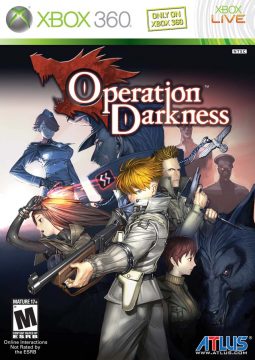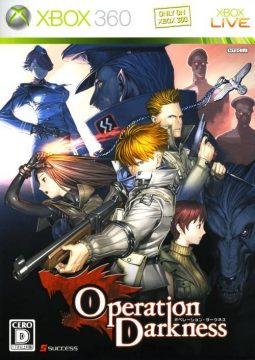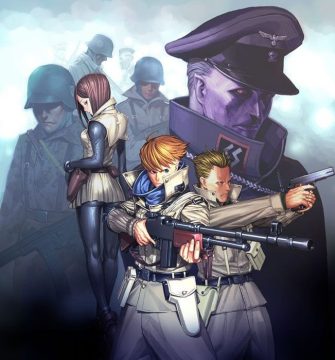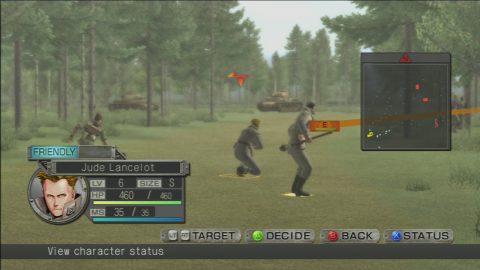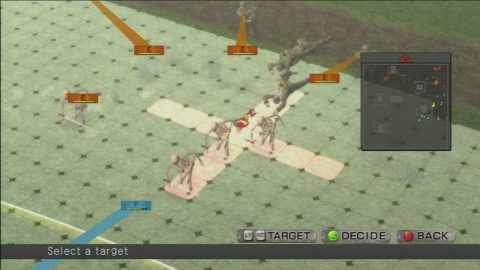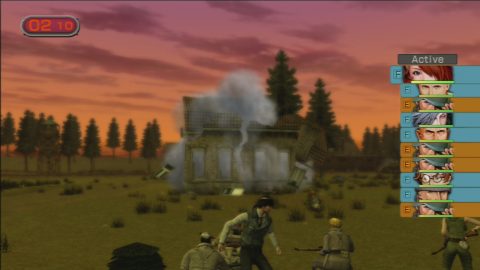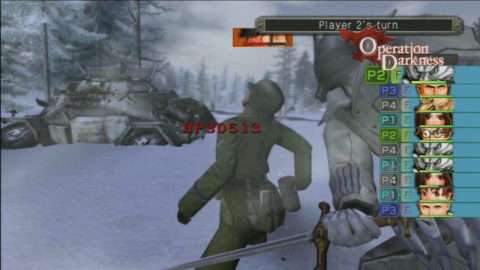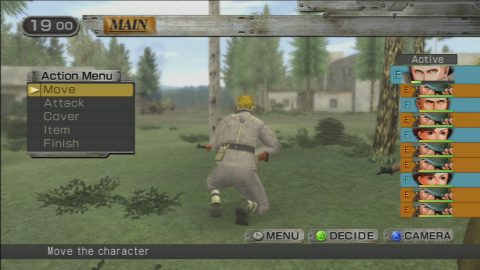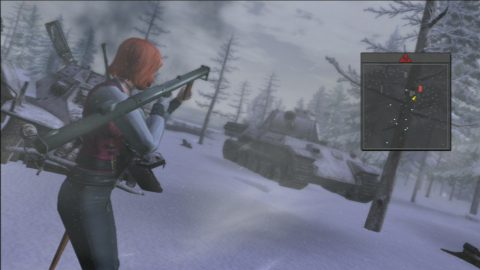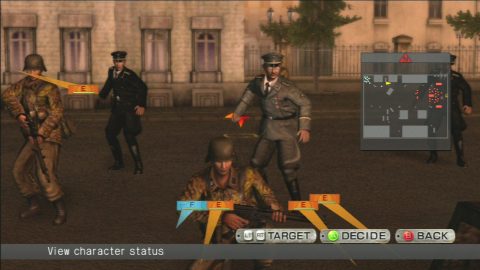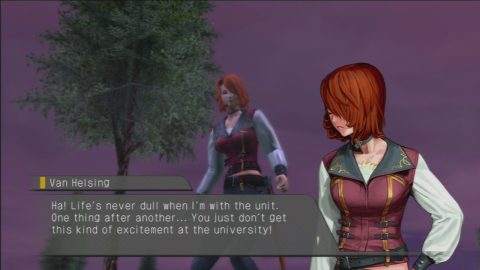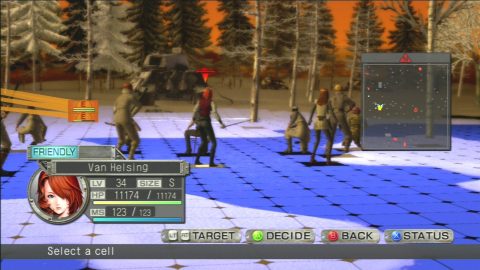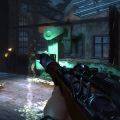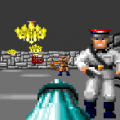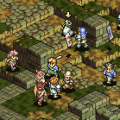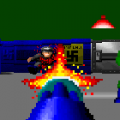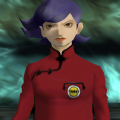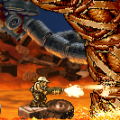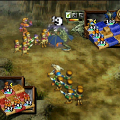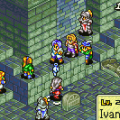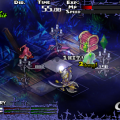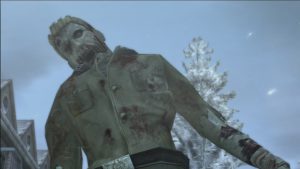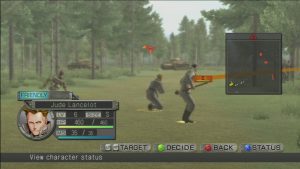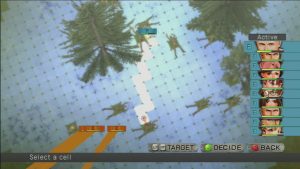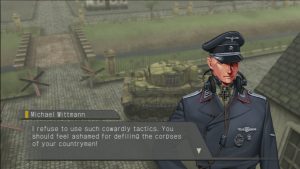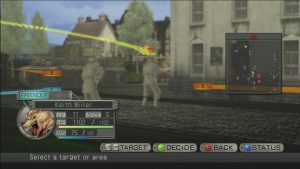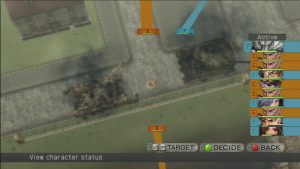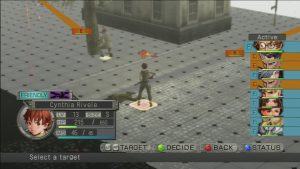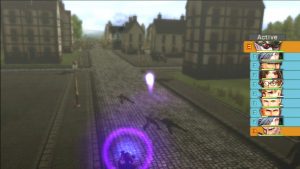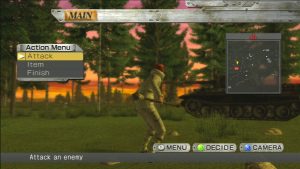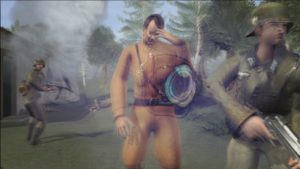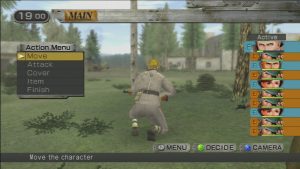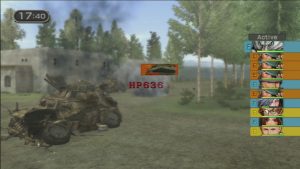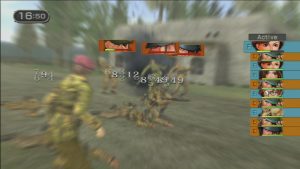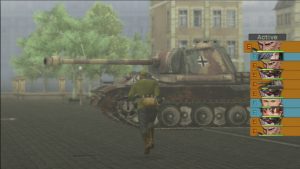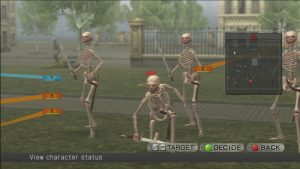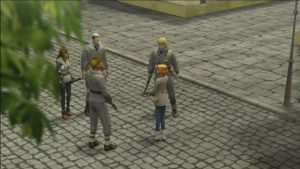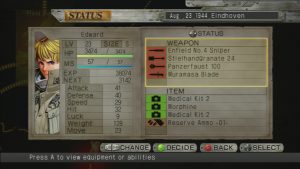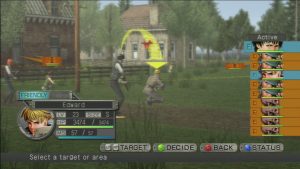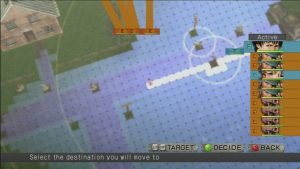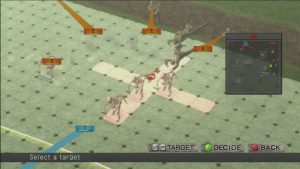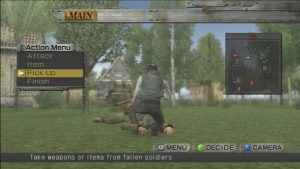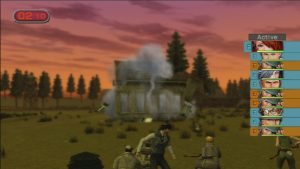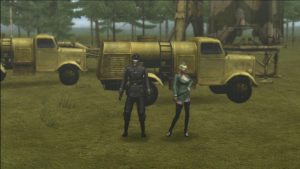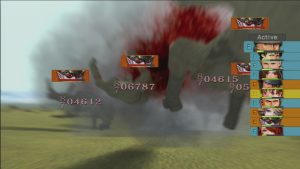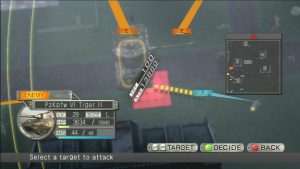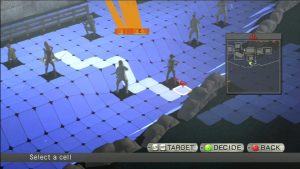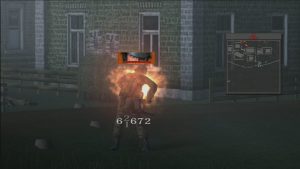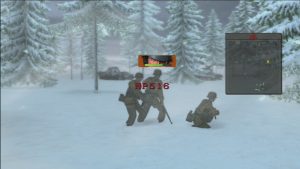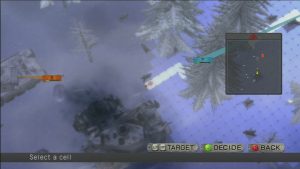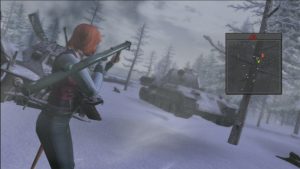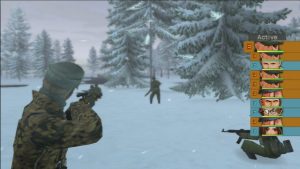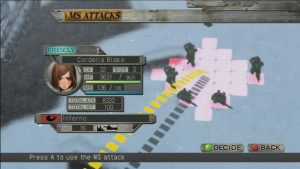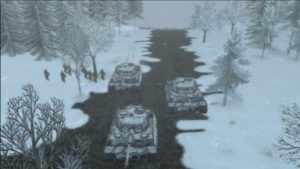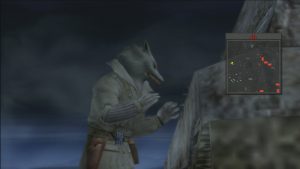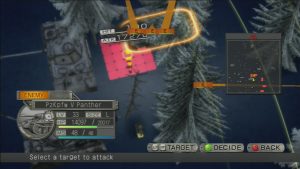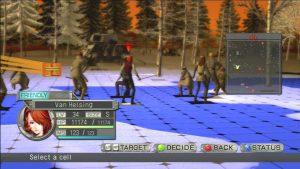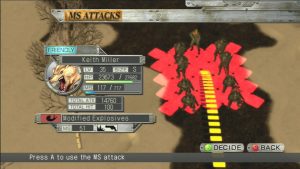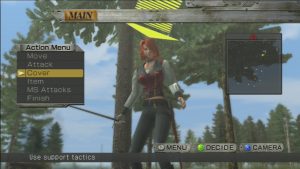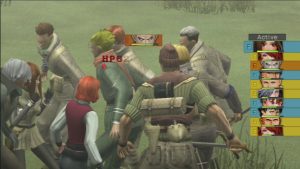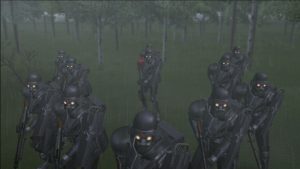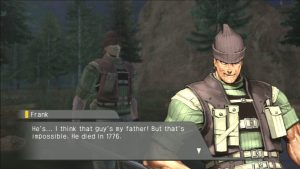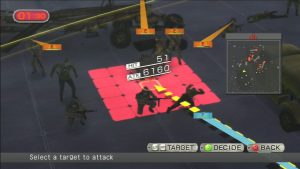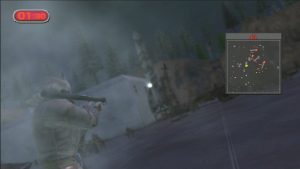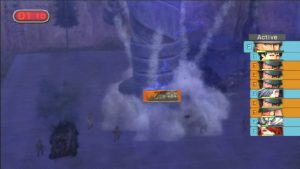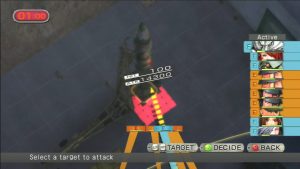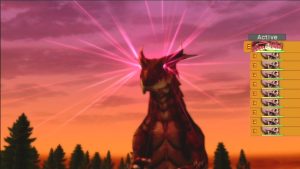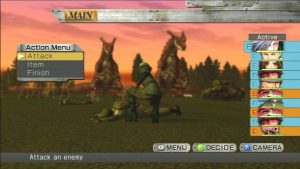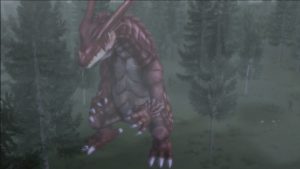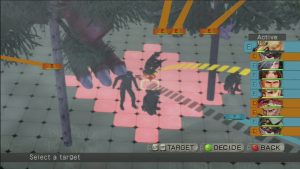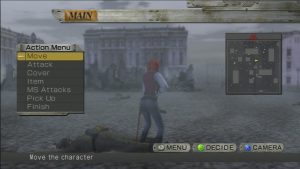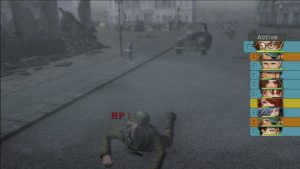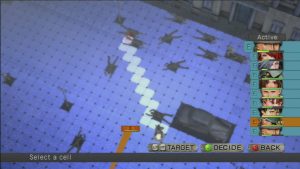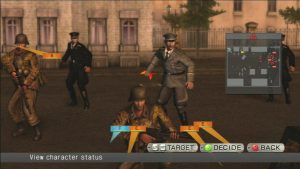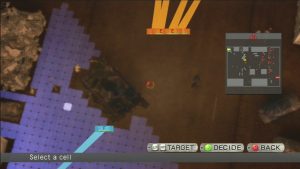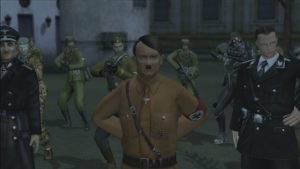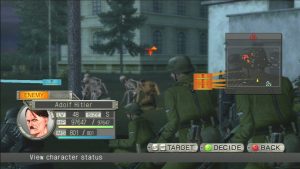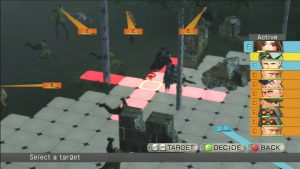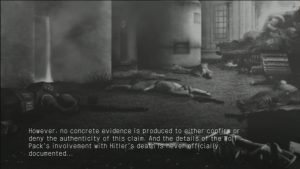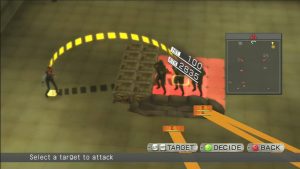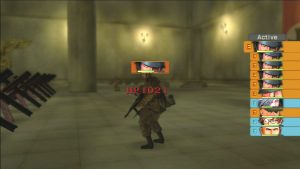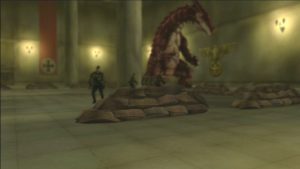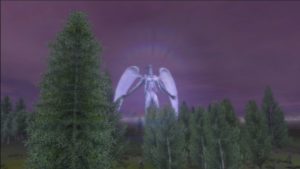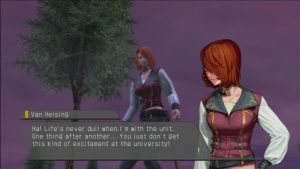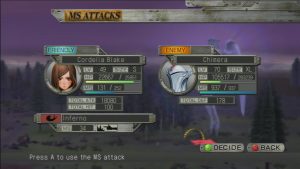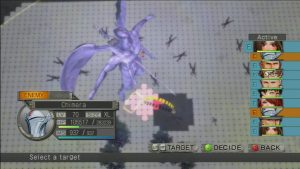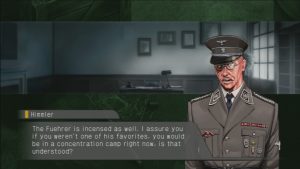Metacritic, due to its out-of-context aggregation of review scores and summaries, is fairly misrepresentative. The meta-score for Operation Darkness, a strategy RPG for the XBox 360 from Success and Atlus, is 46, based on 22 reviews, of which only one is classed as Positive Green. Since publication several websites have closed, now resulting in dead links, and of the surviving reviews the majority condemn Operation Darkness based on lack of understanding (or failure to read the manual), factual inaccuracies, reviewer impatience and general pettiness. They are reflective of a wide-spread failure in games journalism, where unrealistic deadlines, high weekly page quotas and low wages encourage ridicule of games which don’t quite deserve it. Operation Darkness isn’t the greatest strategy-RPG, but it’s certainly worthy of your time and nowhere near as bad as it’s been described.
In many ways it plays like a cross between Sega’s Valkyria Chronicles and Camelot’s Shining Force series, perhaps with a bit of Fire Emblem thrown in too. The military setting might also imply comparison to Nintendo’s Famicom Wars series, but really they’re nothing alike – Operation Darkness has a strong focus on individual character development, rather than faceless grunts. The similarities to Valkyria Chronicles are worth particular mention, since quite a few online have described Operation Darkness as the X360’s nearest equivalent to Sega’s fantastic PS3 exclusive, and they’re not wrong.
Both are set in a fantastical re-imagining of Europe during World War II, and feature supernatural transformations as a central story and gameplay element. Both also contain unique field commands to be called in, individualized trait-enhancing character skills, new weapon purchases & acquisition, character levelling, plus specialization for snipers and bazooka-carrying tank busters. Play badly and there’s also permanent character death – oddly this was condemned in Operation Darkness, though barely mentioned in reviews of Valkyria Chronicles, despite being far stricter in the latter. Hell, there’s even an unavoidable cut-scene in both games where a main character is killed by a sniper, in addition to numerous other smaller similarities. Astonishingly Operation Darkness came out first, and Valkyria Chronicles was released a mere six months later in Japan, making direct influence unlikely. The two games also obviously differ hugely when it comes to their turn-based mechanics, with Valkyria Chronicles mixing in real-time movement and attacks, but Operation Darkness is honestly the closest Xbox 360-exclusive alternative you’ll find.
The one good point that the critics have universally praised is Operation Darkness‘s storyline, which sees centuries-old British werewolves team up with Van Helsing’s granddaughter, an H.P. Lovecraft character, Jack the Ripper, a descendant of Sir Lancelot, and Dr Frankenstein’s monster (collectively known as the Wolf Pack), to fight the Nazis who are teamed up with Count Dracula’s vampire henchmen (the Blood Clan) and are commanding legions of mages, skeletons, zombies, and towering dragons, all while mixing in real-life historical figures and events. Although Atlus’ localisation is a little dry, the game is very effective at blending reality with fiction, basing certain in-game battles around real events. For example at one point the Wolf Pack meets legendary German tank-commander Michael Wittmann, who is disgusted to find his commanders using reanimated corpses to fight.
The colorful roster of characters is one of the game’s high points and, contrary to what some reviewers have said, the European actors used for the voice work do a sterling job, with a diverse and absolutely appropriate range of brogues and lilts. Also, the cool thing with the werewolf characters is that when transformed, all of their stats receive a massive boost, allowing them to travel further, attack harder and receive considerably more damage. The downside is it’s temporary, and lasts only as long as their dwindling Martial Spirit supply (called MS, but basically MP). Since characters will automatically use restoratives when low on health, one trick is to give the wolves restoratives which refill both HP and MS simultaneously, thereby allowing for an almost indefinite transformation (assuming they receive plenty of damage).
Characters
Edward Kyle
The game’s main protagonist, Edward joined the army after his girlfriend Alicia was killed during an air-raid. She was the sister of his lifelong friend Jude, and the two signed up for revenge. During a skirmish in North Africa though Edward is injured, and is saved only through being found by Wolf Pack leader and werewolf James Gallant, who gives him a blood transfusion. After this Gallant requests the two be transferred to the Wolf Pack, anticipating Edward’s transformation later on. He has a burning hatred for the enemy which causes conflict with some Wolf Pack members. Specialises in sniping.
Jude Lancelot
Given his surname and English roots, Jude seems to be a descendant of the fictional Sir Lancelot, a Knight of the Round Table from Arthurian legend (one of the vampire enemies later on is even carrying the sword of Excalibur). His younger sister Alicia and parents were killed in an air raid, so he enlists with Edward for some payback. Not having received a transfusion like Edward, he never receives any special magical attacks, making him the least useful character in the game. He also has a much lower weight limit than the others, limiting the equipment he can carry. Under no circumstances bother levelling him up or giving him rare weapons.
Cordelia Blake
This Lance Corporal is the group’s pyromaniac Fire Starter. Recruited into the Wolf Pack at age 13 due to her special powers, Cordelia is actually of German descent. Her father was captured and tortured to death by the Nazis, while her mother was killed by Carmilla. Although this initially puts her at odds with Edward, he soon comes to fancy her. She doesn’t seem to be based on any specific literary figure, though the official guidebook draws comparison to Stephen King’s Fire Starter. Extremely skilled at pyrokinesis, once she’s levelled up a bit and acquired more spells, she can wipe out entire groups of enemies or even a tank in a single hit.
James Gallant
Leader of the Wolf Pack and a seemingly immortal werewolf belonging to the Fang Clan, Gallant actually participated in the First World War along with his nephew Keith. In 1885 he took on and defeated Count Dracula in Transylvania, assisted by Keith, Frank, Dr Van Helsing (Elisa’s grandfather), Jonathan Harker, and a young Dr Jeckyll. Sixty years later, and working with the British government, he forms an elite squad to take on the vampires assisting Hitler during WWII. When transformed into a werewolf he becomes one of the most powerful characters (his Werewolf Punch can kill a tank), but be careful, because if killed due to running out of restoratives or being run over by a vehicle, it’s instant Game Over.
Keith Miller
His mother was Gallant’s younger sister, who was killed decades ago during the everlasting struggle against the Blood Clan. Carrying a strong Scottish accent he’s another member of the Fang Clan, and like Gallant can transform into a werewolf. He’s actually more useful than his lycanthropic uncle, since dying doesn’t result in a Game Over, meaning you can send him into a difficult situation knowing that Herbert can revive him later. Later on he unlocks an immensely powerful attack using grenades.
Frank Gaunt
Looking at his first name and body riddled with scars, not to mention the game’s premise, you’d be correct in guessing this is the monster of Dr Frankenstein, from Mary Shelley’s famous novel. Much like the creation in the book, and unlike the shambling ogre in the film adaptations, Frank is intelligent and quite philosophical. If you keep him alive long enough during the campaign, one of the missions will pit him against Dr William Frankenstein III, technically his grand-nephew, with some interesting dialogue. Until some of the more powerful recruits show up later, like Van Helsing, Frank has the longest movement range and highest attacks of the squad.
Cynthia Rivele
Not appearing to be based on any literary figure, or possessing any special powers, Cynthia is from Ulster, Ireland, and is the main sniper for the group. She’ll see a lot of use during the game’s start, since by default she comes equipped with an Enfield rifle (incredible range), but towards the end as other characters develop wide-ranging area attacks, her usefulness tapers off. All of her MS attacks require her rifle, so don’t bother changing her equipment.
Herbert West
This creepy fellow is based on the HP Lovecraft character of the same, who succeeded in raising the dead – Gallant describes him as the team’s “reanimator”. Acting as medic, his MS attacks are all defensive, healing allies, curing status elements and reviving the fallen. This makes him both the most important and worst character. Limited only to weapon attacks, he can’t wield a sniper rifle, meaning you’re stuck either with light short-range rifles (like the M1 Garand), or heavier weapons which slow him down. At every feasible opportunity try to get him to attack to keep his EXP up. Known as Herbert East in Atlus’ English localisation, the little red cross on his white armband was digitally removed (presumably because the Red Cross organisation bitches incessantly about its use), though can still be seen in the manual.
Lewis Canton
The Wold Pack’s Second-Lieutenant Colonel and head of counter-intelligence. He pops up later on during a mission on the beach, around the time of the Normandy landings, and later on becomes a constant member of the group. Like Cynthia he’s a sniper expert who doesn’t appear to have any special powers, though he does later unlock a devastating area attack, where he calls in an Air Force bombing plane. It’s not clear how he receives his deus-ex-machina intelligence reports about the enemy, but his information on Germany’s nuclear weapons programme drives the story.
Jack the Ripper
It’s never explained how the infamous and unidentified serial killer who terrorised the White Chapel district of London in 1888 came to be working on the side of the Allies in 1945, but there you go. In an early cut-scene Gallant talks with Frank about having to bring out Jack, and fitting him with some form of restraining device, but how he actually became philosophical about life remains a mystery. An expert with a bayonet and melee combat, Jack’s massive movement range actually makes him quite useful for bazooka duty.
Elisa Van Helsing
Straight from King’s College in London, Elisa is the granddaughter of Dr Van Helsing, who helped defeat Count Dracula. Since his retirement she’s the group’s vampire hunter. She pops up suddenly mid-game, without any firearms, so be sure to hold her back until you can equip some gear. Like Jack she’s a blade expert, though is actually well suited to carrying a bazooka – at least to begin with. Her MS-based Vanquish Attack kills all undead enemies in a single hit, regardless of their HP. Later on when vampires and skeletons become more common you’ll want to remove all equipment except her sword and restoratives, to ensure her as many turns as possible.
Max Neumann
A secret character you can unlock with some work, Max represents the suffering endured by the other side. His wife and daughter were killed in an air raid, and he died during an attack on Berlin, after which his body was taken and fused with machinery ala Robocop. Due to a malfunction he regains his senses and turns on his former commanders. To unlock him you need to have Edward attack him during Mission 19, after which he flees the battle. Max turns up again in Mission 21, and if he’s the last enemy left on the map, and has less than 100% of his health, will be recruited into the Wolf Pack. Possibly named after Maxwell Newman, a British mathematician of German-descent who built one of the first electronic computers in 1948.
Carmilla
This latex-legged-lady is the recurring female vampire antagonist of Operation Darkness, popping up repeatedly as a boss and enacting some dramatic plot turns. Unwaveringly loyal to Sturmbannfeuhrer Alexander Vlado, she commands groups of vampires, mages and the dreaded Totenkopf skeletons. She was also the one who murdered Cordelia’s mother. According to the official guidebook she’s based on the Carmilla novel from 1872 by Joseph Sheridan Le Fanu, which predates Bram Stoker’s Dracula by a couple of decades. Apparently in the novel Carmilla is portrayed as a vampire with lesbian tendencies who preys on young women.
Alexander Vlado
A high ranking officer in the Third Reich and key leader of the Blood Clan, his helping of Hitler is to further his own rather evil ends. As such he’s imbued several human officers with dark magical powers. The main bad guy for the game, he regularly shows up as a boss character, causing harm to all he meets… To say much more would be to reveal some major spoilers.
Heinrich Himmler
With glowing red eyes that reveal his magical enrichment at the hands of the Blood Clan, Himmler is a real-world figure woven into the fictional story of Operation Darkness. Appearing regularly in cut-scenes, seemingly in command of Carmilla, he also shows up as a boss character towards the end.
During play each character on the maps receives a turn to perform moves. A list showing the order is displayed on the right of the screen (which can be toggled with Y to show a mini-map/radar). When a character receives their turn is based on their SPEED stat in conjunction with WEIGHT, which is based on all the gear they’re carrying, tallied up against the stats for all other characters on the map. An especially light and fast character is going to be able to perform two or even three moves before a slower, heavier character can act. This is a masterful set-up, since it forces you to prioritise the best equipment and work efficiently with the available tools – sure, you can load up a character with a bazooka and 10 spare rockets, but they’re going to be slow as hell. Hilariously on one of the most damning reviews of Operation Darkness, the writer tried to claim the game was glitched, and couldn’t make up its mind when to give him his turn, despite the system being clearly explained in the manual, quite obvious if you have even a basic grasp of physics (weight = slow), and is very easily manipulated for your own gains. A magic user like Cordelia needs no weapons, and with a weight of around 5 if you count restoratives, she can dance circles around the enemy. Also, if you run out of ammo you’re given the choice of dumping your gun – one good strategy is to bring weapons you intend to throw out, for example a bazooka to take out a single tank.
When the turn for a characters comes up you can move along the squared grid and then attack (or attack and then move), with movement range being based on stats and chosen skills, and attack range based on specific weapons. Alternatively you can sacrifice moving and attacking to cast a spell, which tend to have decent ranges and area attacks. A few critics complained they couldn’t move AND cast spells at the same time, which is a ridiculous argument – the game is easy enough as it is, and the ability to move while also casting devastating spells would have utterly broken it. The current dynamic works well. The third choice during a turn is to ignore the above and make use of the Cover system.
Even more significant than the game’s setting is the unique, exceptionally brilliant, and inappropriately named Cover system. It actually has nothing to do with taking cover from attacks, and is split between Cover Move, Cover Ambush and Cover Attack.
Cover Move: If you select Cover Move, you must then select another character on the field, and then a point you want the first to run to. When the secondary character performs an action, the first will then run to their pre-determined spot. While they won’t be able to attack, and won’t move until the second character acts, their movement range is increased. Basically: if Keith’s turn comes up, and you see that he’s too far away to engage the enemy, you can choose to have him move to a specific area after an enemy starts moving, or even have him following another member of the Wolf Pack. If there’s a lot of distance to cover, and the turn order shows every member of the Wolf Pack acting after each other, you can choose to have all of them Cover Move on the guy at the bottom of the list. While he’ll have to move normally, and therefore a shorter distance, everyone else will travel much further. In the above screenshot Herbert, and the yellow arrows pointing to him signify that there are several others waiting on his action before they move.
Cover Ambush: Set a character to Cover Ambush and they sacrifice both moving and attacking for that turn, but they will then attack every single enemy who moves and is within range. The downside is that attacks done will only be 1/3 their regular strength, while if they’re attacked they’ll receive 125% damage and stop ambushing (sometimes it’s actually worth attacking your own troops to knock them out of ambush mode prematurely). Also, if an enemy casts a magic spell, such as the Magiers, they won’t actually be ambushed, since it only seems to work for enemy movement and weapon attacks. If you put someone like Cynthia in Ambush mode she’ll be able to dominate the entire map with sniper rifle, which is important when you consider…
Cover Attack: If a character sacrifices their move and attack for that turn, they can be put in Cover Attack, which basically means every single time another character attacks an enemy they’ll join in, assuming they’re in range and have ammo, at 100% normal strength. This in conjunction with Cover Ambush shows not only how masterfully crafted the strategy of Operation Darkness is, but elevates it to genius. If you place one sniper on Ambush mode, and then several others on Cover Attack, it’s possibly to sit back and watch as every enemy that moves gets cut to pieces by three, four, or even all 10 members of your squad.
Obviously there are shortcomings to this, since small arms won’t affect vehicles, and getting attacked while in these modes will cancel them and give you more damage. Plus if your Ambush guy gets cancelled, the remaining characters will just stand there until their next turn comes up (you can have multiple people in Ambush mode). But generally most of the maps are built around taking advantage of this system, which is something unique and not really seen in other strategy RPGs. There are group team-up moves in some games, such as Agarest, but not on quite such a wide-reaching and cohesive scale. While Operation Darkness warrants comparisons to Chess, with its grid-like layout and individualised characters, in terms of functionality the Cover system puts it perhaps closer to the East Asian board game known generally as Go (or igo, weiqi and baduk).
With Go it’s all about control of territory as represented by areas cordoned off by either black or white pieces, or in some cases early in the game controlled entirely by a single piece in an important position. Astute players anticipate the shifting of territories as single pieces are placed in positions which can later be linked up. So it is similar with Operation Darkness, where the maps are arguably the biggest ever featured in a strategy RPG. They vary, but on some (such as Mission 24), they’re 120 by 120 squares, amounting to a total of 14’400 positions on the field. With such open geography there’s little opportunity for choke-points or bottlenecks, and instead success is based around interpreting the map as areas of territory, as defined by a character’s movement and attack ranges, and the protection afforded by buildings and ruined vehicles in-between. Two snipers in the middle of an area, perhaps protected on one side by a destroyed tank and set to Ambush and Attack, will pin-down all infantry across vast sections of map, allowing other characters to move within rocket range and eliminate remaining vehicles or the equally resilient skeletons. Additionally you can control an area by moving someone, such as Keith in werewolf form, directly into enemy range, knowing he will attract and absorb all enemy attacks. This is also a good tactic if you’ve foolishly moved a weaker character ahead and they’re getting pummeled, but aren’t due for another turn for a while.
Operation Darkness features a genuinely well thought out and well balanced strategic system, with an expertly defined set of tools and equipment, where every choice of tactics or weapons or spells feel meaningful. This brings us back to that Metacritic score of 46, and the many negative reviews it’s received.
The universally raised criticism is the awful camera. It’s over-sensitive, refuses to pass through physical obstructions, and is generally unwieldy. There’s no denying it, the camera is not good, though considering that this is basically a glorified version of Chess or Go, it’s annoying but not really a game breaker. Besides which, the game makes things easy by giving you a mini-map/radar, displaying all characters and key obstructions, in addition to letting you cycle through enemies with LT/RT and your own characters with LB/RB. There’s little need even to navigate the map since it’s much quicker after choosing an attack, to cycle through the enemies in a few seconds and note the HIT% you have for each.
Another criticism is the difficulty. Overall it’s a fairly easy strategy game if you’re tactically inclined. Some places online and even the official guide have made a big commotion about how there is only a finite supply of items to buy from the in-game depot, which is only sometimes restocked during story missions. The implication being that every bullet missed is one you’ll need come the end game, and that it’s possible to end up in an unwinnable situation. In reality, you can waste a tremendous amount, as there will be a ton available by the end game, as long as you only buy and equip what you need, being extremely generous but not silly with it.
Related to this are criticisms about the items themselves, and how many you can carry. Some weapons can’t be bought from the depot unless you’ve played the online multiplayer mode – which is actually pointless, since all of them can be found in abundance by looting dead bodies. So don’t worry about it, everything can be acquired playing offline. The looting of enemy bodies is actually an intrinsic part of the game, since not only can you find extra scraps of ammo or meds, but some nice equipment too. So it’s sad to find that some reviewers bitched about being limited to carrying only 5 weapons and 5 support items, ignoring the fact that carrying too much weighs you down. A major component of strategy games is managing resources, and 5 items per character is ample. Some of the most exciting moments in Operation Darkness are when you run out of rockets or medkits, and scramble to a fallen enemy to make use of their own gear. The game is actually very generous with loot drops, and it encourages you to enter battle with the minimum and then wage a guerrilla war, stealing as you go, because if you wade in with a full pack you’re going to lose turns. Personally, I clocked over 30 missions using around a hundred Stielhandgranate, all of which were looted. There’s a fantastic trio of missions right before the final mission, where you can’t resupply between them, meaning all you’ve got is what you carry in and everything else is OSP (On Site Procurement). Timid players might be frightened at reading this, but rest assured that if you’ve been playing intelligently up to this point you should be ready to handle it, and besides which, you’re still able to save between missions, so it’s thrilling yet painless.
A further criticism, related to equipment, is that like Valkyria Chronicles you don’t know what you’re up against until you’re in the field, which can make preparation a matter of guesswork, or restarting a mission. There is merit in this argument, but it’s also something that happens with many other, highly praised strategy titles. Almost every story mission in Valkyria Chronicles featured something unpredictable. In fact something championed in many games is the element of surprise, when you’re required to adapt to a changing situation. Besides, werewolves with rockets, rifles for the snipers and a few weaponless magicians is usually a good bet regardless. Furthermore the argument is ultimately redundant, because even if it bluntly described what you’d initially encounter, almost all missions in Operation Darkness feature waves of reinforcements after a set number of enemies are dispatched. Some of the most exhilarating moments are when you encounter a third wave of skeletons or tanks with no ammo in your guns and no meds in your backpack, forcing you into a climactic rush to loot a few spare Panzerfaust rockets and Morphine before the enemy’s turn comes round. As mentioned earlier the loot drops, though random, are rather generous, so scavenging among the dead has an empowering feel to it. Inevitably though there are those who dislike unpredictability in their games, in which case they should just use a guide. With knowledge of where enemies will appear it’s possible to set-up Ambush and Attack before they even arrive, making the game obscenely easy and slightly pointless.
Then there’s the permanent character death, which adds tension, encourages careful planning, and makes victory all the sweeter. However, permadeath in Operation Darkness is mostly easy to avoid. Every character can be equipped with skills which can be levelled up, such as Detect Weakness which increases the damage% of gun attacks; or Guard, which allows you to reduce damage by half; or a variety of MS based skills which increase total MS, increase MS strength in addition to cost, or another which reduces overall cost. The #1 essential skill is Auto Recovery, which fundamentally changes how Operation Darkness is played, and in itself is a revolutionary idea for the genre. If a character is attacked and their HP drops below 20% they automatically use a restorative, starting with the weakest. Basically this gives you additional health bars, up to 5 if you so choose, and allows you to take massive damage repeatedly, even a tank round in the face, without dying. The game is designed around exploiting this.
However, in the event that you send a weak character into enemy territory while short on restoratives and they get killed, you can revive them using Herbert. His range is pretty good so you don’t have to get too close, and it’s quite cheap so you can do it a few times before needing an MS restorative. It’s also much more lenient than Valkyria Chronicles, where if a character goes down they will permanently die if an enemy touches their fallen body, or three turns pass. In Operation Darkness you have until the end of a mission to deal with it, regardless of how long it takes or how many enemies run over your comrade. Even then, what if Herbert dies? Well, focus on keeping Herbert safe, because he’s the only one who can sort things out when it goes awry.
Having said that, there is one legitimate criticism regarding character deaths, and that’s the fact Gallant, Cordelia and Edward are all essential story characters who aren’t allowed to die, not even a little bit. If they fall it’s instant Game Over. They’re unlikely to die as a result of getting attacked, as long as you equip enough medkits, but any character touched by a vehicle dies instantly. This can make levels with tanks a bit tricky. It makes sense if you complete the mission and a story character is dead – then you should be forced to restart. But it’s a bit unfair to have Gallant run over by a tank and not be given the chance to let Herbert revive him, especially if his turn is up next. One solution would have been to put the game into “danger mode”, where a klaxon sounds and you’re instructed to revive them before the mission ends. As it stands, be sure to keep these three away from vehicles. Everyone else can die and be resurrected by Herbert without worry, though.
A lot has also been said about the graphics and animation. They are pretty low tech, considering the hardware, though everything has its own distinct, stylized look. It’s not water colors like Valkyria Chronicles, and it’s not anime like Disgaea, but it’s got an unusual flavor. It’s the same with the camera problems: this is a turn-based strategy game, and there’s little need for dynamic lighting, detailed textures, or delicately crafted polygon models. They’re functional with a distinct look, and that’s fine. The colors can be a little drab at times, and an injection of intensity could have made it look better, but the visuals are not a game breaker.
Having said all of the above, there are some issues to raise against Operation Darkness. One is the Valhalla Reports – from Mission 13 onwards a random member of a specific enemy type on each map carries 1 of 12 Valhalla Reports; the enemy type is always the same, but which specific enemy is randomized, and there is no hint who carries it. If you collect all 12 reports by looting the appointed soldier, you unlock 20 bonus missions called The Eagle’s Nest, accessible after completing Mission 26. Devoid of scenery or story, they’re all about pure tactics and are a great place to level up. These stages comprise roughly 1/3 of the game’s overall content: in addition to 27 Story Missions and 15 Armed Recon missions, which are basically there to earn EXP and some bonus skills. So the Eagle’s Nest is pretty substantial in terms of quantity, and yet it can easily be missed. And you can’t replay story missions, so if you miss one page, that’s it.
The problem with this scenario is that between Missions 13 and 24 you’re always scrambling from one corpse to another hoping to stumble on it. Most of the time you end up wiping out all enemies but one, and then have to run around Benny Hill style while the sole survivor gives chase. You also have to make sure to cancel all Ambush and Attackers, because otherwise when he moves he could get killed and end the mission before finding it. The whole concept sucks, since it cripples the strategy by forcing you to divert your attention. It would have been better if they’d given you a clue as to who carried it, or made the Eagle’s Nest unlockable via some other means. For secret characters like Max it’s no so bad, since if you miss him it’s just a small percentage of gameplay, but 20 missions is a bit excessive to lose out on.
Another problem, which Valkyria Chronicles rather elegantly solved, is balanced levelling for characters. Sega opted to grant universal EXP after mission completion which could be spent on character classes at the training camp – meaning, for example, every sniper could be levelled up as a whole. With Operation Darkness you have to level each of the 11 main characters individually by using them. This is a terrible system for casual strategy players who rely on strong characters, since it leaves weaker ones like Herbert under-levelled and unused. There is a concession though, in that simply attacking with a character will grant EXP, regardless of if they kill the enemy. It’s quite possible to have a low-level character with a bazooka do only a fraction of damage to a tank, but shoot up three levels in doing so. The advice here is be smart when managing characters: if a strong and a weaker character both have a turn coming up, have the strong guy loot bodies or something, while the weaker one pulls off the kill shot and the big EXP. If you can’t manage that, just grind your weaker guys in the Armed Recon missions. Oh, and don’t bother with the generic recruits, except for a single female to act as Ambush spotter and looter, since if the generics do any heavy lifting you’re just wasting the EXP.
Relating to the difficulty is the fact you can’t save mid-mission, unlike with Valkyria Chronicles. Admittedly with battles lasting around 45 minutes each, and some towards the end topping the one hour mark, it would be nice to have a sleep function – perhaps a temporary save that deletes itself after you load it, similar to how Shenmue did it.
Further niggles include the music, which is generic, tuneless and utterly forgettable. Then there’s the fact there’s an Achievement which encourages you to rush through in 35 hours, when really you’re looking at around 60 hours for an enjoyable play through. Please ignore this and just enjoy the game at your own pace – rushing for a fictional medal will only ruin the experience. Finally, there’s no post-game content, unlike Valkyria Chronicles, though you can still mess around in the Armed Recon and Eagle’s Nest missions.
Operation Darkness has some issues, but it’s still a pretty good strategy game. In the wake of Valkyria Chronicles, and other strategy games later in the generation like the rebooted X-Com, it surely has some visual and and UI issues, plus some other odd and annoying design choices that the other games don’t. Still, it doesn’t quite deserve the reputation it has, and as long as you can put up with its quirks, it’s still worth looking into to.
It never received a PAL release, so Europeans are out of luck unless they import an NTSC-U system. Given the scorn poured on it by the press, it’s little surprise no one wanted to release it in Europe. The Japanese release meanwhile, for those with Japanese 360s, apparently has English subtitles for the Japanese dialogue, if your system’s internal language is set to English (according to feedback comments on Play-Asia). Keep in mind this text was not translated by Atlus, so will differ from the US release.
Detailed interview with the developer: Success
In conjunction with Atlus an official guide was released. It contains detailed maps, information tables, tips and walkthroughs. Not all the strategy recommendations are useful, since there are some far more lethal plans of attack than the ones described, but for those worried about the difficulty it’s a nice hand holder. The best thing about it though is an examination of literary influences at the back, and an interview with the developer, Success, and localizer, Atlus. We’re reposting the text here, for your enjoyment. All credit for this goes to DoubleJump Books. The questions were asked by readers on the DoubleJump forums, and the HardcoreGamer forums (the magazine, which is unrelated to our own site). The answers are below. They make for sad reading, since clearly Ogura-san and his team invested a lot of sincere energy in the project, and for whatever reason, despite crafting an enjoyable game of merit, it was universally panned by critics who just didn’t get it.
What’s especially interesting about the interview are the detailed descriptions of plans for two follow up games (which will now never be made), and the large amount of content which had to be cut from Operation Darkness prior to completion.
Q: Shinogu – How the heck did the premise for this game come to fruition? It must have been nigh impossible to pitch even the concept to the bosses!
Answer: (Ken Ogura, Producer of Operation Darkness, SUCCESS Corporation)
I was the Lead Designer and Project Lead on the game, so the concept came from my idea. Since I’m a big fan of 19th and 20th century adventure, war, and horror novels, I incorporated elements from various books and movies as motifs into the game concept.
The first draft of the game development plan was completed around April of 2003. At the time, we were originally planning the platform to be PlayStation2, and the premise wasn’t as wild as it is now. We did have the release of a US version in our sights, but the original idea was more of a serious drama with an ensemble cast, say for example, a mix of HBO’s “Band of Brothers” mini-series and a touch of gothica from F. Paul Wilson’s horror novel The Keep.
From there we went through a couple of twists and turns to get a GO for the project, and our development team was organized in March 2004. Compared to other companies, SUCCESS has relatively more flexibility when it comes to approving projects, and there is a tendency for more unique projects in getting the final GO. I think that’s why the game came to be, and it’s also possible that it wouldn’t have been approved by a larger game company.
Q: TOON SNAKE – Given that this game’s genre is mostly popular in Japan, why was the game made for the Xbox 360, which is by far the least popular console in that country?
Answer: (Ken Ogura)
As mentioned in the previous question, back in 2003 the game was planned to be for the PlayStation2. However, right around that time, Microsoft presented us with details on their new Xbox 360 system, and that changed the whole story. Around the same time, there were rumors about Sony and Nintendo (PS3 and Wii) planning their next-gen consoles, so taking that into account, we predicted that by the time we would be finished with the development of this game, all three major consoles would be out on the market. Especially in Japan, there’s a precedence of next-gen consoles being rapidly accepted and creating a whole new market. We thought that putting the game on the PlayStation2 would be somewhat harder to market, so we shifted our strategy and aimed for a next-gen console. So now it came down to choosing which of the three next-gen platforms to go with.
I. At the time, only Microsoft’s Xbox 360 had development environments and specs ready.
II. Microsoft had failed with the original Xbox, but we assumed they would do better with the new platform.
III. Xbox 360 has strong networking features, full support, and a good development environment.
IV. It is a U.S.-made hardware, and by having strong brands such as the Halo series, we believed it would be a successful hardware in the North American market.
For the reasons above, we chose to go with the Xbox 360. When you take the North American market into account, number IV becomes a major factor. The previous Xbox console did not get good reception in Japan, but with a very attractive game lineup coming to the Xbox 360, I was speculating that the Xbox 360 would sell about one million units during the time span of the December 2005 launch through the second quarter of 2007. That forecast was based on previous hardware lifetime sales data from various Japanese consoles, but the outcome fell far shorter than expectations. I would’ve never imagined that it be so low in Japan. [bitter laugh]
Q: Noccy – Given that Adolf Hitler himself rarely makes an appearance in games set during WWII, what made you decide to include him as a character in your game?
Answer: (Ken Ogura)
There are a number of games based on WWII, and I believe this is because the Nazis were a clear villain and therefore easier to incorporate as a game idea. However, although most of these games use the Nazis as the villain, their leader often does not make an appearance. If this were a novel or a movie, Hitler would’ve naturally made a showing. I’ve always had a question as to the way games treated Hitler almost as a taboo. He is a prominent war criminal of the 20th century, but to make it a taboo or act as if he never existed seems unnecessary. What we did was not in any way to idealize him, but to introduce the historical fact that Hitler was one of the leaders that drew the world into war. In the process, we judged that mixing some level of fiction with history would not be a problem.
This is sort of off topic, but Jack Higgins’ novel The Eagle Has Landed was a story about German airborne troops infiltrating mainland England during the time of war to assassinate Churchill. Also in Frederick Forsyth’s The Day of the Jackal, there is an assassin who tries to kill Charles de Gaulle (the French President). There is a thrill factor in these sorts of fiction novels that introduce the suspense of using real historical people. One of the aims for using Hitler was to incorporate this suspense into the game.
In my original idea, Operation Darkness was set to be a trilogy, using WWII as the starting point. The first game was to be WWII, the second game the proxy war between East and West during the 1960s to 1970s Cold War era, and the third game to be the modern day war against terrorism. The gist is that after the introduction of a clear and dominant evil, and to continue on to show the absence of the clear villain and the chaos that flows after it, it was necessary to place Hitler in Operation Darkness as a symbol of the true evil.
Q:KulturTerror – Does the game feature Hitler’s obsession with the occult, such as the Aryans and the Lost Land or the Spear of Longinus, or are the Nazis just a template for a zany fantasy game?
Answer: (Ken Ogura)
When we decided to use the WWII setting and use the Nazis and Hitler as the main evil of the game, we incorporated Hitler’s obsession with occultism into the story. Some arguments state that Hitler had some connections with the Thule Society and had been searching for the Spear of Longinus. These facts probably gave inspiration to writers of future generations as a topic of interest. For instance, the movie “Raiders of the Lost Ark” and “Indiana Jones and the Last Crusade” show clear influences of this.
In actual history, Hitler’s obsession with occultism had no major influence on the outcome of the war, but in Operation Darkness, we included the concept of “What if Hitler’s occultism really came to fruition?” There are several movies and novels writing about the “what if” factors of WWII (such as “What if Germany won?” and “What if Germany’s secret weapon were completed?”), but in Operation Darkness, we tried to balance the historical basis and the occult elements.
Q: Riverking – What do you think is the hardest part of making a next-gen game, for smaller developers?
Answer: (Ken Ogura)
The main concern is the inflation of development costs. Especially with next-gen consoles, the number of people involved with the project increases, and it takes longer to develop. So the overall development cost becomes the biggest problem. We assume that compared to the average cost of other companies’ next-gen titles, Operation Darkness’s development cost is about a little under half, but funding that amount was substantially harder for us as a medium-sized company. To handle this problem, developers must create a new business model to somehow streamline development and reduce excess costs. Otherwise, smaller developers will eventually be driven out of competition.
Q: snowstorm52 – What was the reason behind creating the story, characters, and world that this game takes place in?
Answer: (Ken Ogura)
I’ve already addressed a lot of this in earlier questions, but there’s more to the story. Back in 2003 when we first started, about 80% of the plot was already created, with the basic setting based in WWII, starting from the Western Front and ending in Berlin, right before the end of the war. Then, we researched various resources on the history of the war and battle logs, and then we weaved together real events with fiction.
John Campbell, a renowned science-fiction writer, has called this method of intertwining fiction and non-fiction as “extrapolation.” In doing so, I had a very hard time trying to incorporate scenes and situations without conflicting with history. And in this process, I (a) created the main character and his antagonist, (b) show their inner struggles, (c) introduced a narrator-type character, the leader of the Wolf Pack, (d) created additional friendlies, (e) wrote plot turning points, and (f) addressed issues of death and sacrifice. I believe this is closer to how Hollywood script writers construct their plots.
Q: snowstorm52 – What are some of the things that didn’t quite make the cut to be in the game, whether it be due to time or budget constraints? Was there anything you particularly are upset about that didn’t get included?
Answer: (Ken Ogura)
Due to cost and development time, about twenty stages, characters, and weapons had to be cut. Also, in our original plan, the main story campaign was to incorporate Co-op, which would then seamlessly span across single player and Co-op missions and then merge into a wide frontline offensive that would run concurrently. The idea was great, but again, it had to be cut due to cost, time, and technical difficulties.
Our biggest regret is that we couldn’t fully incorporate the wide use of shaders and lighting effects that the Xbox 360 was capable of (they call the Xbox 360 the “Shader Monster”). Cost, time, and technical difficulties are the direct reasons for this, but it was also my error in judgement. If I have a chance at creating a sequel, I would definitely like to address this.
Q: lobitoh – Since the game is based on strategy, I figured it out that most weapons are from world wars. Are there any bonus weapons that are maybe futuristic?
Answer: (Sammy Matsushima, Project Lead, Atlus U.S.A.)
To fit within the setting of WWII, most of the weaponry in the game are actual weapons used during that time period. However, although not futuristic, there are special weapons, items, and abilities that are based on legend and classic fantasy.
Q: LastEpoch – When translating the game from Japanese to English, were there any sort of cultural sensitivities you had to observe, or vice versa, or were you more free to say things in English that would not be allowed in Japan?
Answer: (Jason Ruper, Editor, Atlus U.S.A.)
I remember watching “Band of Brothers” with my girlfriend for reference before working on the project. Unfortunately, I made the mistake of watching the concentration camp episode, and I should mention that my girlfriend was Jewish, with relatives who had been held in those camps. She didn’t handle the visuals very well, to say the least.
In the game, the developers were sensitive enough to take these sentiments into account. Although the Holocaust is a significant and important piece of history, it was not specifically necessary to our heroes’ storylines or the development of their characters. Therefore, it is not explicitly referenced in the game, and we on the localization team decided their judgement was very sound. We took it one step further and removed all references to “concentration camps” altogether, just to be safe.
We agree that, artistically, making people feel uncomfortable can have its merits, especially when trying to make a bold statement. However, we’re happy to report that in both the Japanese and the American versions, all parties are in agreement that the Holocaust is just not appropriate subject matter for this particular game.
Other than that, there were no boundaries. There are incidents of torture, depictions of blood, and of course the requisite anti-German and anti-English slang words!
Q: LastEpoch – What kind of media (i.e. books, movies, other games, etc.) had the most influence on the story of Operation Darkness?
Answer: (Ken Ogura)
As stated above, since the game was planned to be a trilogy, we needed a storyteller that could span across all three eras. To do this, we introduced werewolves which have long lives, almost to the point of being immortal. This idea is heavily influenced from Robert R. McCammon’s book The Wolf Hour.
Also, in order to battle head on with the Nazis’ occult forces, the vampires and other undead, and the tanks and armored vehicles, we needed a strong character with superhuman powers. Werewolves became the ideal motif. However, even though the werewolves and vampires in this game have super-human powers, they are depicted as not being fully able to withstand the power of modern weaponry. This is an important aspect to keep in mind.

